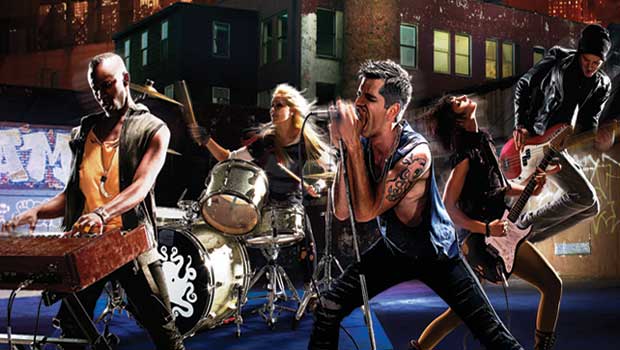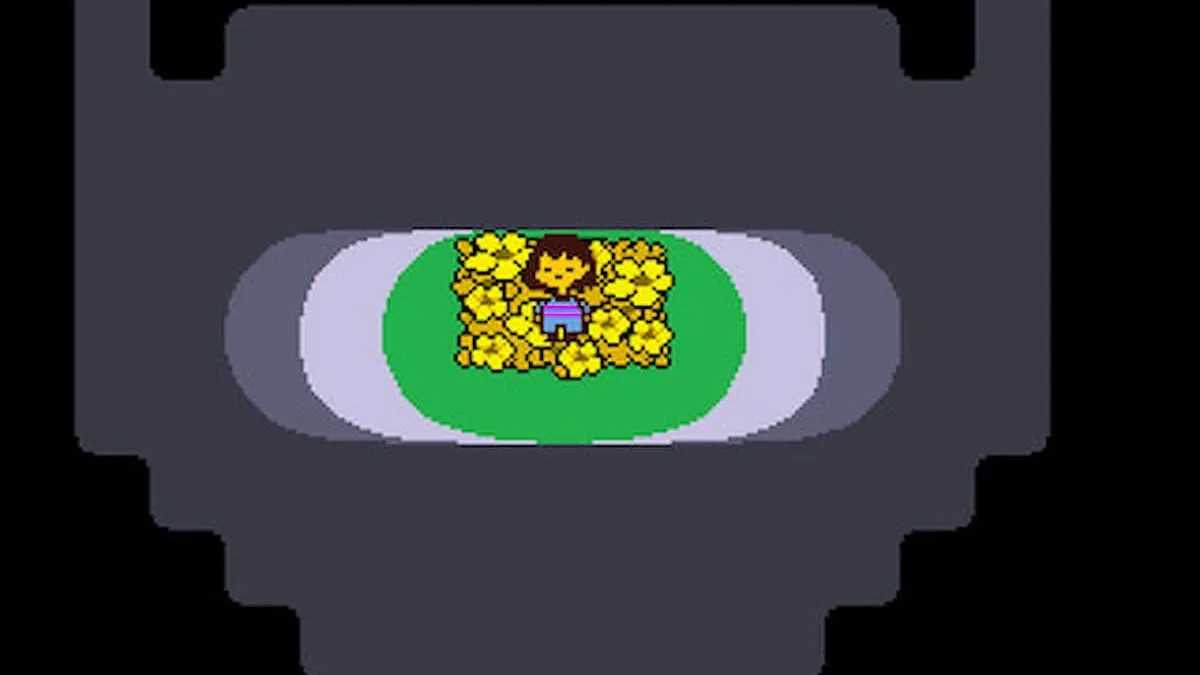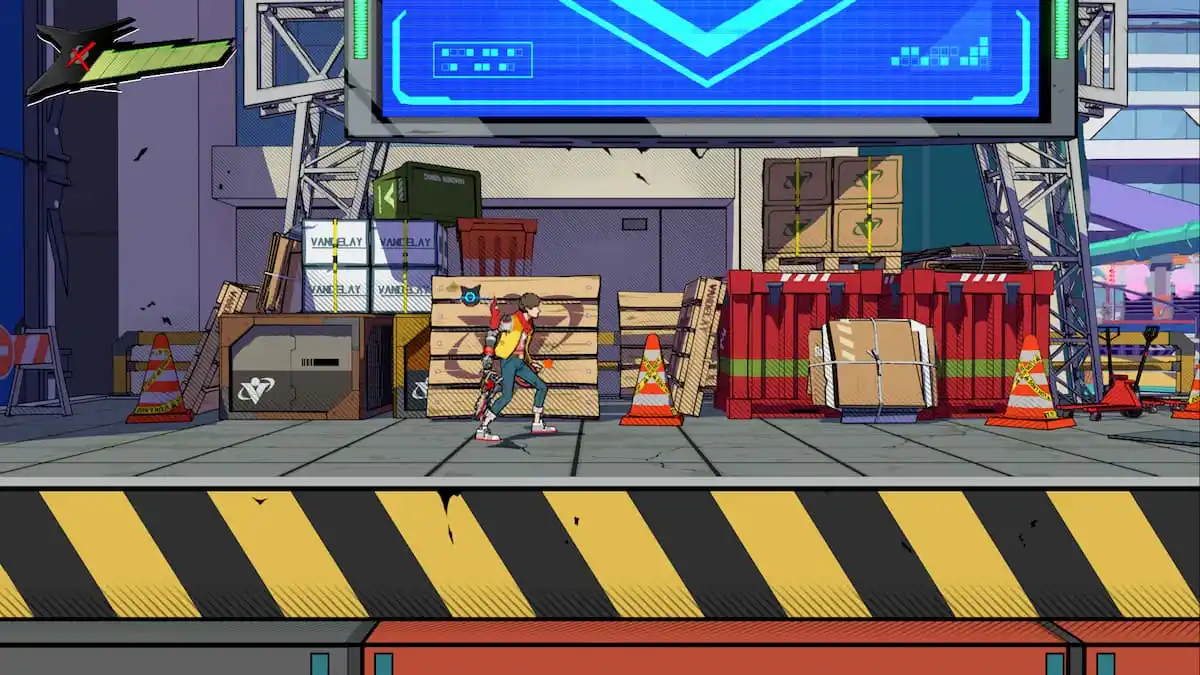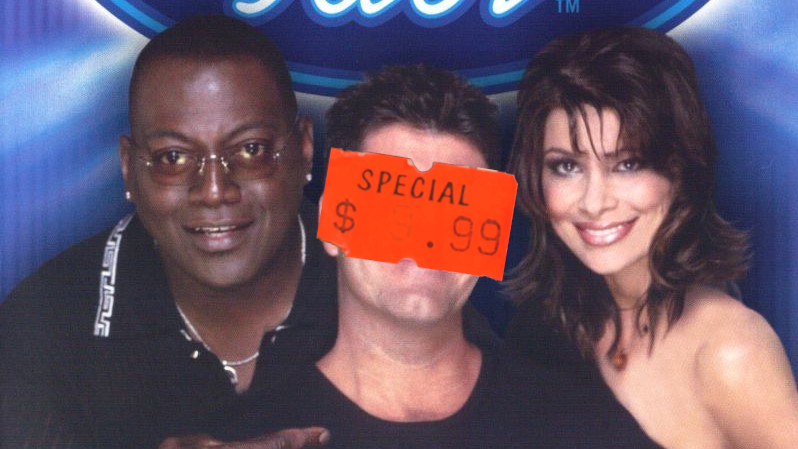By now, you’ve already heard quite a bit about Rock Band 3. No sense in repeating too much information, so here’s the scoop: it brings in vocal harmonies, it adds a new keyboard peripheral to the mix, and extends gameplay (and the potential for real-world musicianship) with a “Pro” mode.
But those are the details at their most basic. When looked at a whole, you’ll see that Rock Band 3 is actually adding an overwhelming amount of content above and beyond what we’d seen previously in the genre. As Harmonix’s Daniel Sussman puts it, the game is “a disruptive title in the music category.”
“We’ve actually very aware that folks in the industry and watching the industry in this category in particular are wondering, you know, when is it all going to end?” he admits. “And our reaction to that has been really to double down on our development.”
I had a chance to not only see the title in action, but to get my hands on some of the new features, including a sampling of the game’s new “Pro” mode. Continue after the jump for some of the first details on Rock Band 3.

The music collection and new sorting features, or “I don’t want to scroll through 500 Foo Fighters songs to find a song I want to play.”
At this point, there are well over 1,500 songs available to play in the Rock Band library; with things like Rock Band Network, it’s looking to surpass the 2,000-song mark in the near future. The Rock Band 3 disc itself will contain songs from 83 artists, including tracks from bands such as The Doors, Metric, Dio, Huey Lewis and the News, Phoenix, and more. (A list of the announced tracks can be found here.)
With the song catalog expanding, Harmonix completely redesigned the back end of how the music library and track sorting works within the game. On the surface, it’s your standard list, not dissimilar to what you might see in previous iterations of the title. But under the hood, they’ve added filtering options, allowing you to get to the types of tracks you want more easily than before. For example, if you only want to see songs found on the Rock Band 3 disc, you can do that. Want to only see medium-length songs found on the Rock Band 3 disc? How about short alternative rock songs released in the ’90s? Not a problem — you can mix and match the filters as you like, helping you pare down the list to suit your mood or situation.
Borrowing a page from the Rock Band Network, the game will also now let you rate tracks using a “lighters” system. One lighter? Worst song ever. Five lighters? Maybe this is the song you lost your virginity to, who knows. The point is further personalizing your collection and your experience. Songs rated low will appear in random set lists with less frequency; songs rated highly will appear more often. You can even account for ratings when using the aforementioned filter system.
OMG, is that a keyboard!?!

For the first time in a full-band game, Rock Band 3 will introduce keyboard gameplay; Mad Catz will be making and distributing the peripheral.
“It’s actually been sort of a contentious point on the development team,” Sussman says of the addition. “[I was] unconvinced that there would be enough songs — like, good songs — to support a critical mass of content on the disc, to support a keyboard peripheral. I was proven wrong.”
The Doors “Break On Through (To The Other Side)” is a good example, a keyboard-heavy track that lends itself well to the use of the peripheral. Or “Sister Christian,” which I recently bitched wasn’t included a recent Night Ranger DLC pack; the song’s intro is nearly a minute worth of keyboards and vocals only.
The peripheral itself is a full two-octave keyboard. When playing the standard game, you’ll be confined to five keys, marked on the keyboard by the standard red, yellow, blue, and green colors. When playing in the game’s “Pro” mode, however, you’re dealing with something else completely — the hardest difficulty levels may find you playing up and down the keyboard’s 25 notes.

Even on the easiest modes, there’s a bit of a learning curve when first getting your fingers on this thing. Even having limited experience playing piano (chords and such), the disconnect between what was happening on the screen and the keyboard itself took about half a song to get through. But once I got into the groove, it was smooth sailing, and as much fun as you’d guess it to be.
Sussman pointed out that you don’t need to own this standalone peripheral to play the keyboard parts in songs. If you already have a guitar controller, the standard game will support that. On the flip side, guitar and bass tracks can also be played using the keyboard controller; this is good news, since there will likely be many tracks in your library that feature zero keyboard parts.
It should be noted that during the playable demo, the keyboard sat on a stand. It’ll be possible to put it on your lap or a table as well. It also appears that you can put a strap on the peripheral.
We’re going to need a bigger stage
With the addition of keyboards and three-part vocal harmonies, Rock Band 3 allows for up to seven players to rock out at once. We saw this demonstrated with Queen’s “Bohemian Rhapsody,” one of the game’s on-disc songs that utilized all of the instruments at once. It’s hard to imagine playing this song in a full-band game without keyboards and vocal harmonies; you’ll be glad it wasn’t included in the previously released Queen tracks.
Set lists and battles go social, and “The Nick Chester Case”
While the ability to create customized set lists was a feature introduced in Rock Band 2, Rock Band 3 takes it to another level. Players will be able to save set lists this time, giving them names, and even logos. Setlists can also be shared online.
Additionally power over “Battle of the Bands” concept from Rock Band 2 — where Harmonix would frequently issue challenge-style set lists for players to compete in — has been given to the player. You’ll now be able to create your own battles, share them with friends or opening them up for the world to play. This doesn’t have to be done from just your console, either — players can create battles online via rockband.com.
It’ll also be possible to push new battles and other content to friends via social networks like Facebook and Twitter.
“We have a design case we modeled this on called the ‘Nick Chester Case.’,” says the game’s lead designer, Dan “I Cheat at Arm Wrestling” Teasdale. “And the ‘Nick Chester Case’ is that the Night Ranger DLC pack comes out, and he wants to play Night Ranger with his friends. So he goes through, sees the announcement, finds the DLC online, creates the battle before he even has it on his console, sends it to me, and spams it on his Twitter feed and I unfollow him from Twitter.”
Rock Band Pro answers the burning question, “What the fuck is the point?”
Keyboards are great, and the new song sorting features and other core game changes will be welcome additions for fans of the series. But it’s the introduction of “Rock Band Pro” — a new game mode that attempts to help translate in-game skills to genuine musical skill — that’s the big news here. This new mode (which applies to guitar, keyboard, and drums) attempts to have players, for all intents and purposes, actually playing the songs — rather than a gem-by-gem simulation of the song’s notes.
Drums are fairly straightforward — strap the three Mad Catz cymbals to your existing Rock Band 2 (or The Beatles: Rock Band) kit and you’re good to go. In Pro mode, the game will recognize this, and will replace some notes with colored cymbal gems where appropriate. The transition from standard mode to Pro wasn’t a huge leap for me; playing Rock Band drums for almost four years had given me more than the principal skills to rock a beat on a basic kit.

Pro Keyboards are a bit more interesting, taking advantage of the entire two-octave keyboard and having the player actually tapping out real notes. On the game’s easiest modes, single notes will appear, but it’s important to know that these notes are pitch-accurate — translate these notes to a real keyboard, and you’ll be playing the basic melody or keyboard line in a song. Up the ante to expert mode, and you’ll find that the game will actually require you to play all of the notes, chords and all.
But the real news here is the game’s support for a Pro Guitar, a new peripheral distributed by Mad Catz. Based on the Fender Mustang, the guitar features 17 frets and six strings, for a total of — are you sitting down? — 102 buttons on the fretboard. The guitar also features six “strings” for picking out and strumming notes.

In case you don’t see where this is going — like the Pro Keyboard, the guitar charts in this mode will actually have you playing the notes in the song. Again, on the most basic modes, you’ll be plucking out single notes; as you increase difficulty, the game introduces chords. We saw a demo of the most difficult mode while Dio’s “Rainbow in the Dark” played on the screen. As Sussman put it, what we saw was a “shit show of musical content,” with notes coming down the track at an alarming rate. But as a guitarist, it was easy to see that all of the notes were in the right places, from the power chords to the individual notes in the song’s blistering solo.
Harmonix understands that these most difficult modes won’t be for everyone, but it’s an interesting bridge between simply playing a game and holding a real guitar in your hands. Starting at the easiest level, it’s likely that most players (especially those who’ve played Rock Band guitar on expert) will feel at home. Before they know it, the idea is to get them more comfortable with a real six-string axe.
“Our perspective on this is to not necessarily to turn people into virtuoso guitar players,” Sussman says. “I think the line that we use in the studio is that we want to get you to the point where you can beat out a song at a campfire, and not necessarily jump on stage. But what we’ve seen in our focus testing is that after an hour of, kind of, trainer development and a couple of songs, people actually come out of that one hour and they have basic guitar chops.”

“I think we’re trying to answer the persistent question about music games,” he remarks, “as in, ‘What the fuck is the point?’ You know, for people that have gotten really good at Guitar Hero or Rock Band or whatever, they’re not musicians. We’re trying to take gameplay in a way that actually pushes people to genuine musicianship.”
While the guitar we were shown wasn’t functional yet, I did get a chance to strap it on and hold it in my hand. Surprisingly, placing my fingers on the fret buttons in a number of chord positions felt comfortable and natural. It does, however, seem like it would be uncomfortable or awkward to slide between notes up and down the fretboard, and it’s unclear how the in-game note charting will take into account things like bending notes on strings. I hope to get my hands on the guitar next week at E3, and hopefully get a few answers to these questions in the process.
Rock Band 3 is out this fall for Xbox 360, PlayStation 3, Wii, and DS.
More details on the instruments:
Rock Band 3 instruments price and details
Harmonix/MTV partners with Fender on Guitar/Controller hybrid





Published: Jun 10, 2010 11:01 pm